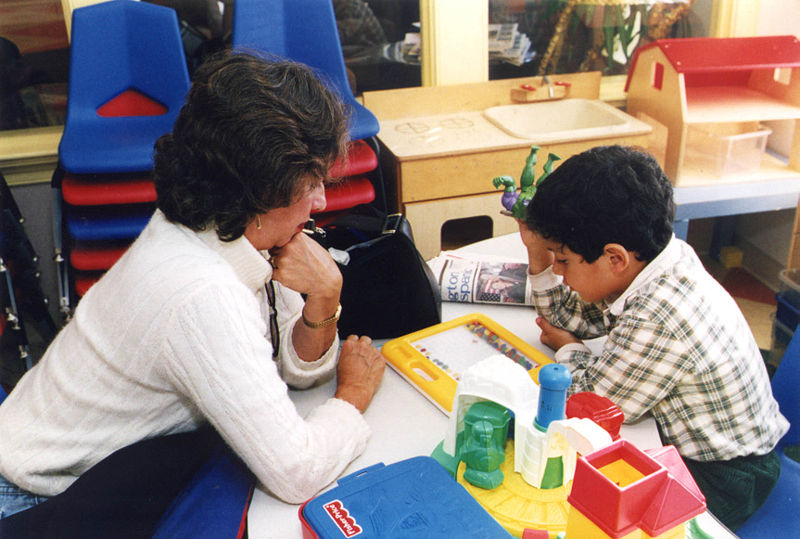Stimulus package disappoints those who need it most: students with disabilities
Dscot018 // en.wikibooks
Remote learning has caused special needs students to lose a critical part of their education: in-person interaction with their teachers.
May 3, 2020
Students with disabilities — perhaps some of the most vulnerable individuals in the education system — could be disadvantaged in the COVID-19 stimulus package, as Congress provided Secretary of Education Betsy Devos with the right to provide waivers for IDEA implementation.
According to the U.S. Department of Education, by the Individuals with Disabilities Act (IDEA), “the federal government has an ongoing obligation to support activities that contribute to positive results for children with disabilities, enabling those children to leave productive and independent adult lives.” Passed in 1975, IDEA ensures schools provide “free appropriate public education” to children with disabilities and a say in this education to parents and legal guardians.
The act covers children from the day they are born until their high school graduation or the age of 21, whichever is first. In order for a child to be eligible for IDEA, a student must have a disability which requires special accommodations to thrive and make progress in a school environment.
Under the COVID-19 stimulus bill, Devos can allow states to not provide necessary educational services to students with special needs.
According to The Hill, the approximately 7 million children “who traditionally receive specialized education are now learning from home, which makes managing their individualized education programs (IEPs) more difficult.” Under IDEA, schools teaching students with disabilities are mandated to give them an education comparable to their peers.
However, Angela Morabito, an Education Department spokeswoman, had emphasized that “Secretary DeVos has been clear from the beginning that she is committed to ensuring all students, including students with disabilities, can continue their education during this national emergency.”
New York Times reporter Erika Green notes that the waiver could pose a significant disadvantage for students who receive servies such as tutoring, behavioral assistance, and hands-on services like physical and occupational therapy. As many schools across the country shift entire curriculums and programs online, “special education, which is administered through meticulously devised plans called Individualized Education Programs,” could be upended because they often “require extensive services that are not easily transferred to the internet.”
Such makes it possible for educators to lower the quality of, or altogether eliminate, education for children with disabilities, simply because remote learning makes some, or even all, of its features infeasible. Opting out of IDEA would give schools an easily accessible backdoor to escape lawsuits.
Seattle resident Jennifer Gratzer, a parent of a child with special needs, fears that all of her 10-year-old son’s school progress will be lost. She said that after a 350-page complaint, “he has made progress with services like occupational therapy, speech therapy and one-on-one aid, afforded to special needs students like him under the Individuals with Disabilities Education Act.”
The waiver was called “unnecessary” by the Education Trust and other groups, who commented that a temporary disadvantage will be converted into a permanent learning loss, comparing it to opening a “Pandora’s box.”
Indeed, students with disabilities need as much support as they can get, and a gap in learning makes it increasingly difficult for them to continue to make progress. As it is, students with special education already face barriers and achievement gaps compared to their counterparts.
A study from University of Texas at Permian Basin emphasized that “although special needs education has changed dramatically to incorporate these new methods, classroom styles and adaptive technologies, professionals still struggle to close the achievement gap and figure out why these changes have not proved more successful.” Since students who enter special education are generally held at lower standards, students in special education are disadvantaged from the moment they enter the education system.
Connie Kasari, a human development professor at UCLA’s Graduate School of Education and Information Studies, added that “[i]t’s one thing to put a child who can understand in front of a computer screen to do their lesson, do their homework, and quite another thing when the child doesn’t understand that.”
School districts must consider instituting unique remote learning methods for special education students. Possible methods include one-on-one video calls with the student and providing the parent with learning materials, so the parent can facilitate learning with the help of teachers in real time. Ultimately, it is absolutely necessary that California not accept Secretary Devos’ IDEA waivers and instead act to provide special needs individuals their right to an adequate education and all the support they need, no matter their socioeconomic status.



